Inventor's Vengeance
Back to Contents of Issue: May 2004
|
|
|
|
by Leo Lewis |
|
|
In seconds, the illusion of state-of-the-art glamour is replaced with the sort of cheap knockabout surrealism that's always good for a laugh in the old Road Runner cartoons: "World's No. 1 Inventor," proclaims a sign glued to a battered wooden door.
A knock on this enticing portal brings the inventor's faithful assistants shuffling along to open it. Inside is a terrifyingly messy cross between Q's laboratory, Frankenstein's workshop and Armageddon waged only with scraps of paper. Beyond a low wall made of cardboard boxes and stacks of yellowing magazines, the top of the great man's head is barely visible. He is busy, and the visitor is invited to explore Dr. NakaMats's domain until the inventor is ready.
This is the lair of a man regarded by some as the greatest scientist on earth. He holds the record for the largest number of personally held patents, which at more than 3,000 eclipses the famous holder of the No. 2 spot, Thomas Edison. He has won the Inventors' Grand Prix a record 50 times and has a prodigious number of honorary fellowships at universities across the globe. He is a regular figure on Japanese television, and is occasionally mobbed in the street.
NakaMats's vast collection of patents has suddenly thrust him into the very center of an acrimonious public debate on Japanese intellectual property. In late January, the Tokyo District Court created widespread corporate panic when it ordered a technology company to pay JPY20 billion to a former employee who invented the blue LED "all by himself." An editorial in the Nikkei Shimbun gravely reported that "few doubt the enormity of the implications the court decision will have" for corporate Japan.
The Japanese government, as worried as the many corporations affected by the ruling, has frenziedly set about reworking the rules on intellectual property. Japan is hugely inventive -- eight of the world's top ten companies ranked by number of patent applications last year were Japanese. The trick is to harness that talent in a way that doesn't trigger a stampede of litigation.
The experience of Dr. NakaMats, who sells ideas to the highest bidders, has become of great interest to corporate Japan.
Years before assuming his more cosmopolitan stage title, Yoshiro Nakamatsu, a top engineering student, proved his flair for invention. As a small child he came up with the design for a plastic hand pump that is still sold across the world. While still a student, he began research that led to his invention of the 3.5-inch computer floppy disc -- the royalties from which have kept him a very rich man.
At the middle of the stand is a tiny bottle of Love Jet, another of his inventions and his latest bestseller. The tiny, unambiguously boxed spray promises the same general effects as Viagra, but boasting the considerable advantages of working instantaneously and being topically applied. For doubters of its astonishing powers, Dr. NakaMats provides a baffling "formula of sexual sensitivity." Confusing mathematical symbols abound, but the gist is supplied alongside: The square root of BxM, for example, refers to "ugly degree of body shape."
A sideways scramble down a diploma-lined passage takes one past the smudged porthole of "Research Lab No. 3." Inside, a fearsome-looking easy chair has had its headrest altered so that thousands of electrical wires splay out towards the spot where its occupant's head would be.
At the end of the passage is a room crammed with Dr. NakaMats's inventions through the ages. There is his design for the first ever crop-dusting equipment, along with the machinery that first made music sampling possible. There is the golf club that revolutionized putting in the 80s, and crammed atop a buckled metal cabinet are several boxes of his patented "Flying Shoes" -- boots with springs on the bottom that sparked a short-lived Tokyo craze about ten years ago. Other devices include the mysterious "Antigravity Float Vibrate 3D Sonic System."
Photographs of the good doctor with astronauts, academics and adorers adorn the walls. There are certificates dating from when IBM bought 14 of his patents, a case with copies of his many popular self-help books and even a history of his life by a famous Japanese cartoonist.
None of this bedlam fully prepares one for the confusion of Dr. NakaMats's office itself. It is like the hobby room of a cranky uncle, but with a pinstriped city-slicker beaming out from a leather chair at the center. Behind him is an ice-skating boot perched on four wheels and apparently powered by a fuel cell of his devising. To its right is a magnificent painting of an inventors' theme park he is planning to construct outside Tokyo. Strewn across his desk are his favorite inventions: gizmos and gadgetry that include, of course, the now-iconic floppy disc.
Pride of place on the desk is given to a small statue of Archimedes sitting in his bath -- a joke that plays on Dr. NakaMats's famous talent for coming up with his greatest ideas while swimming. The statue was presented by a caucus of Russian scientists who, in compiling a list of history's greatest scientists, put him on a par with Faraday and Curie.
He does his own work without assistance, does not think highly of other inventors around the world, living or dead, and does not appear to doubt his talents for a second. He takes the trouble to explain how, having won his university place against 12,000 applicants, he never missed a single lecture, displaying a fully-stamped attendance card to prove this.
Asked to identify the greatest inventor ever, Dr. NakaMats immediately points to a vast portrait of his mother. It dominates the room, and her memory dominates much of his conversation and written output. In a self-authored book called "The legend of Dr. NakaMats's inventions," a section of poems and pictures is devoted to her, along with the admission: "Dr. NakaMats has not accepted death of mother."
"I write books for people so they can understand how I do this, but the basic spirit of invention is love. I studied from my mother and this was what she taught me. My first invention -- this pump -- I designed when I was a small boy during the war. It was so cold that my mother's hands were shaking and she could not pour the soy sauce from one bottle to another, so I invented the pump out of love for my mother. Now I do everything with that spirit. Toyota, Mercedes, they are trying to design fuel cells because of the money -- I am doing it out of love for the environment."
It is soon clear that Dr. NakaMats is not a man who relishes gray areas. Gesticulating violently, he dismisses outright the suggestion that he has ever failed at anything. He hates the idea of borrowing money, and claims that his businesses have always been self-sufficient. He deplores the state of Japanese education, sadly describing a process of intellectual "levelling down."
He adds that it was his desire to change the education system that drew him to politics. Many Japanese remember with a smirk Dr. NakaMats's failed campaigns to run for mayor of Tokyo. The subject is decidedly delicate.
"In this world, there are visible inventions and invisible inventions. As an inventor of great intelligence, I think I can come up with both. The invention of politics will be an invisible one. There are many stupid people involved in Japanese politics, and I want to clean that all up. The present education system hates genius, I would encourage it. I would do it all in the sprit of love."
As a parting shot, he fires out what is perhaps the oddest contention of the day: "I'm going to live to 144 years old," he grins. "I have redone my body. I eat one meal a day, I don't drink or smoke, and I lift 35.5 tons in heavy mass training. I think walking or jogging is bad for the brain, so I do not recommend it and prefer swimming. I sleep in a special chair of my own invention that allows me to sleep only four hours per night.
"Oh, and I always drink this," he says, pushing over a steaming cup of brain drink.
@ |
|
Note: The function "email this page" is currently not supported for this page.


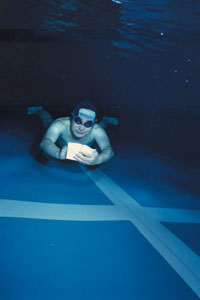 Nestled among the glitz of the world's wealthiest investment banks and most expensive hotels, the polished granite exterior of Doctor Yoshiro NakaMats's Innovation Institute looks like a thousand other glittering Tokyo facades. Gleaming plaques direct visitors along a corridor to a futuristic elevator, which noiselessly conveys them to the penthouse floor.
Nestled among the glitz of the world's wealthiest investment banks and most expensive hotels, the polished granite exterior of Doctor Yoshiro NakaMats's Innovation Institute looks like a thousand other glittering Tokyo facades. Gleaming plaques direct visitors along a corridor to a futuristic elevator, which noiselessly conveys them to the penthouse floor.
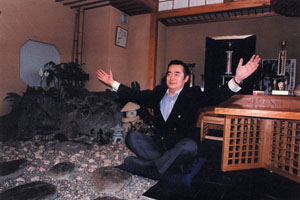 It is immediately obvious that NakaMats's chaotic cavern plays the triple roles of gadget test center, sales room and self-tribute museum. Facing the entrance is a cluttered stand with some of his culinary inventions. Dr. NakaMats's Brain Drink, for example, is his patented health formula that promises anyone with a teapot the twin benefits of weight loss and "Yummy Nutri Brain." The packet design (also his patent) suggests that purchasers look at themselves in the reflective surface and then flex it to show how easily their faces can go from portly to pert. The back of the packet provides an early hint of the staggering narcissism to follow: A brief resume of Dr. NakaMats includes the information that he was once "selected as one of the most expensive 12 speakers in the world."
It is immediately obvious that NakaMats's chaotic cavern plays the triple roles of gadget test center, sales room and self-tribute museum. Facing the entrance is a cluttered stand with some of his culinary inventions. Dr. NakaMats's Brain Drink, for example, is his patented health formula that promises anyone with a teapot the twin benefits of weight loss and "Yummy Nutri Brain." The packet design (also his patent) suggests that purchasers look at themselves in the reflective surface and then flex it to show how easily their faces can go from portly to pert. The back of the packet provides an early hint of the staggering narcissism to follow: A brief resume of Dr. NakaMats includes the information that he was once "selected as one of the most expensive 12 speakers in the world."
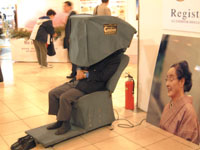 Dr. NakaMats may be a 75-year-old boffin, but he does not take prisoners when he talks. He knows he is academically gifted and has also worked hard to hone his scientific skills. "People have now got the image of inventors as some sort of street scientist. Not so well-educated, but a man of crazy ideas. His clothes are tattered and dirty and he is basically the sort of inventor we see in Back To The Future movies. People look at these people and think of them as abnormal, or just laugh. I'm not like that at all. I studied engineering at Tokyo Imperial University, which is the most difficult place to enter. And then I went to law school because real invention should be done with a knowledge of scientific and non-scientific matters."
Dr. NakaMats may be a 75-year-old boffin, but he does not take prisoners when he talks. He knows he is academically gifted and has also worked hard to hone his scientific skills. "People have now got the image of inventors as some sort of street scientist. Not so well-educated, but a man of crazy ideas. His clothes are tattered and dirty and he is basically the sort of inventor we see in Back To The Future movies. People look at these people and think of them as abnormal, or just laugh. I'm not like that at all. I studied engineering at Tokyo Imperial University, which is the most difficult place to enter. And then I went to law school because real invention should be done with a knowledge of scientific and non-scientific matters."
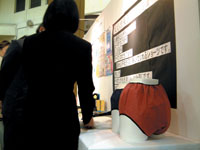 After a second's thought, he adds the Love Jet spray to this list. He explains that his formula may have the effect of promoting more fertility among Japanese, and thus reversing the long and worrying decline in the country's birth-rate. "Love, you see, love for my people!" he bellows with an emphatic thump on the desk.
After a second's thought, he adds the Love Jet spray to this list. He explains that his formula may have the effect of promoting more fertility among Japanese, and thus reversing the long and worrying decline in the country's birth-rate. "Love, you see, love for my people!" he bellows with an emphatic thump on the desk.
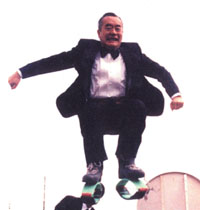 Asked what he is currently working on, Dr. NakaMats roughly shoves some papers aside to reveal a white cardboard model house. This, he explains, is the patented Dr. NakaMats Home -- the product of many reinventions of the norms of construction. He opens a drawer to reveal the blueprints, crafted in his own tidy hand. The sprawling abode is currently half-built, but he is greatly looking forward to being the "marmot" that tests it. Inside are two special rooms -- one "calm", one "dynamic" -- that are critical to the invention process.
Asked what he is currently working on, Dr. NakaMats roughly shoves some papers aside to reveal a white cardboard model house. This, he explains, is the patented Dr. NakaMats Home -- the product of many reinventions of the norms of construction. He opens a drawer to reveal the blueprints, crafted in his own tidy hand. The sprawling abode is currently half-built, but he is greatly looking forward to being the "marmot" that tests it. Inside are two special rooms -- one "calm", one "dynamic" -- that are critical to the invention process.



